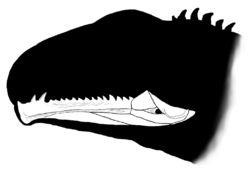Biology:Sphenovipera
| Sphenovipera | |
|---|---|

| |
| A silhouette showing the jaw of Sphenovipera in medial view | |
| Scientific classification | |
| Domain: | Eukaryota |
| Kingdom: | Animalia |
| Phylum: | Chordata |
| Class: | Reptilia |
| Order: | Rhynchocephalia |
| Family: | Sphenodontidae |
| Genus: | †Sphenovipera Reynoso, 2005[1] |
| Species | |
| |
Sphenovipera jimmysjoyi is an extinct species of sphenodontian dated from the Middle Jurassic.[1][2] If was discovered in the lower part of the La Boca Formation located in Tamaulipas, Mexico.[1] Only the lower jaw of this organism has been discovered and studied.[1] It is possibly the only species of rhynchocephalian yet discovered to show evidence of venom delivery.[1]
Etymology
Sphenovipera was named by Reynoso in 2005. The name alludes to sphenodontians via Spheno- and -vipera is Latin for "venomous snake."[1]
Description
Sphenovipera jimmysjoyi is only known from a single mostly complete mandible, around 6.2 millimetres (1⁄4 in) in length. The authors of the describing study stated that mandible and has several characteristics indicative of venom delivery. This includes large curved fangs with grooves seen in other animals that use low-pressure venom delivery, such as colubrid snakes. The authors of the describing study also suggested that the gape was wider and the bite was weaker than that of other sphenodontians.[1] The interpretation of Sphenovipera as venomous has been contested, with other authors noting that the grooves on the teeth are only shallow, and that the fangs teeth are unspecialised, and that the gape is unknowable without elements of the skull.[3]
Taxonomy
Sphenovipera is a member of Neosphenodontia. Some studies have placed it as a part of Sphenodontinae,[4] while others have disputed this.[5]
References
- ↑ Jump up to: 1.0 1.1 1.2 1.3 1.4 1.5 1.6 1.7 Reynoso, Victor-Hugo (September 2005). "Possible evidence of a venom apparatus in a Middle Jurassic Sphenodontian from the Huizachal Red Beds of Tamaulipas, Mexico". Journal of Vertebrate Paleontology 25 (3): 646–654. doi:10.1671/0272-4634(2005)025[0646:PEOAVA2.0.CO;2]. https://www.researchgate.net/publication/40663418.
- ↑ "†Sphenovipera Reynoso 2005". Paleobiology Database. Fossilworks. http://www.fossilworks.org/cgi-bin/bridge.pl?a=taxonInfo&taxon_no=252026. Retrieved 19 July 2016.
- ↑ Folinsbee, Kaila E.; Müller, Johannes; Reisz, Robert R. (2007-06-12). "Canine grooves: morphology, function, and relevance to venom" (in en). Journal of Vertebrate Paleontology 27 (2): 547–551. doi:10.1671/0272-4634(2007)27[547:CGMFAR2.0.CO;2]. ISSN 0272-4634. http://www.tandfonline.com/doi/abs/10.1671/0272-4634%282007%2927%5B547%3ACGMFAR%5D2.0.CO%3B2.
- ↑ Herrera-Flores, Jorge A.; Stubbs, Thomas L.; Elsler, Armin; Benton, Michael J. (July 2018). "Taxonomic reassessment of Clevosaurus latidens Fraser, 1993 (Lepidosauria, Rhynchocephalia) and rhynchocephalian phylogeny based on parsimony and Bayesian inference" (in en). Journal of Paleontology 92 (4): 734–742. doi:10.1017/jpa.2017.136. ISSN 0022-3360. https://www.cambridge.org/core/product/identifier/S0022336017001366/type/journal_article.
- ↑ Apesteguía, Sebastián; Garberoglio, Fernando F.; Gómez, Raúl O. (2021-09-30). "Earliest Tuatara Relative (Lepidosauria: Sphenodontinae) from Southern Continents". Ameghiniana 58 (5). doi:10.5710/AMGH.13.07.2021.3442. ISSN 0002-7014. https://bioone.org/journals/ameghiniana/volume-58/issue-5/AMGH.13.07.2021.3442/Earliest-Tuatara-Relative-Lepidosauria-Sphenodontinae-from-Southern-Continents/10.5710/AMGH.13.07.2021.3442.full.
Wikidata ☰ Q9340234 entry
 |

